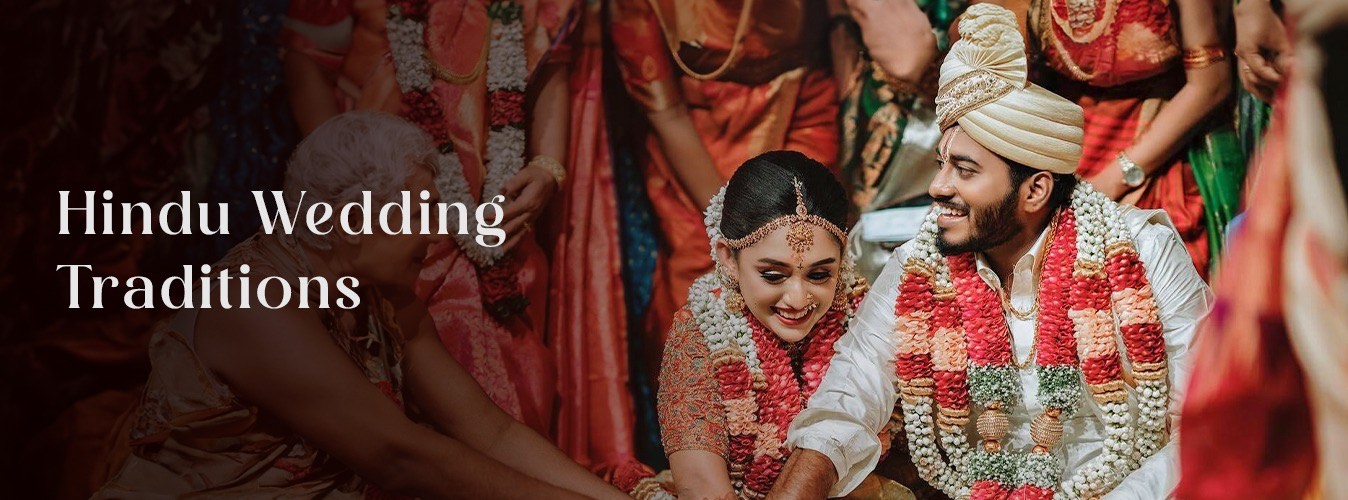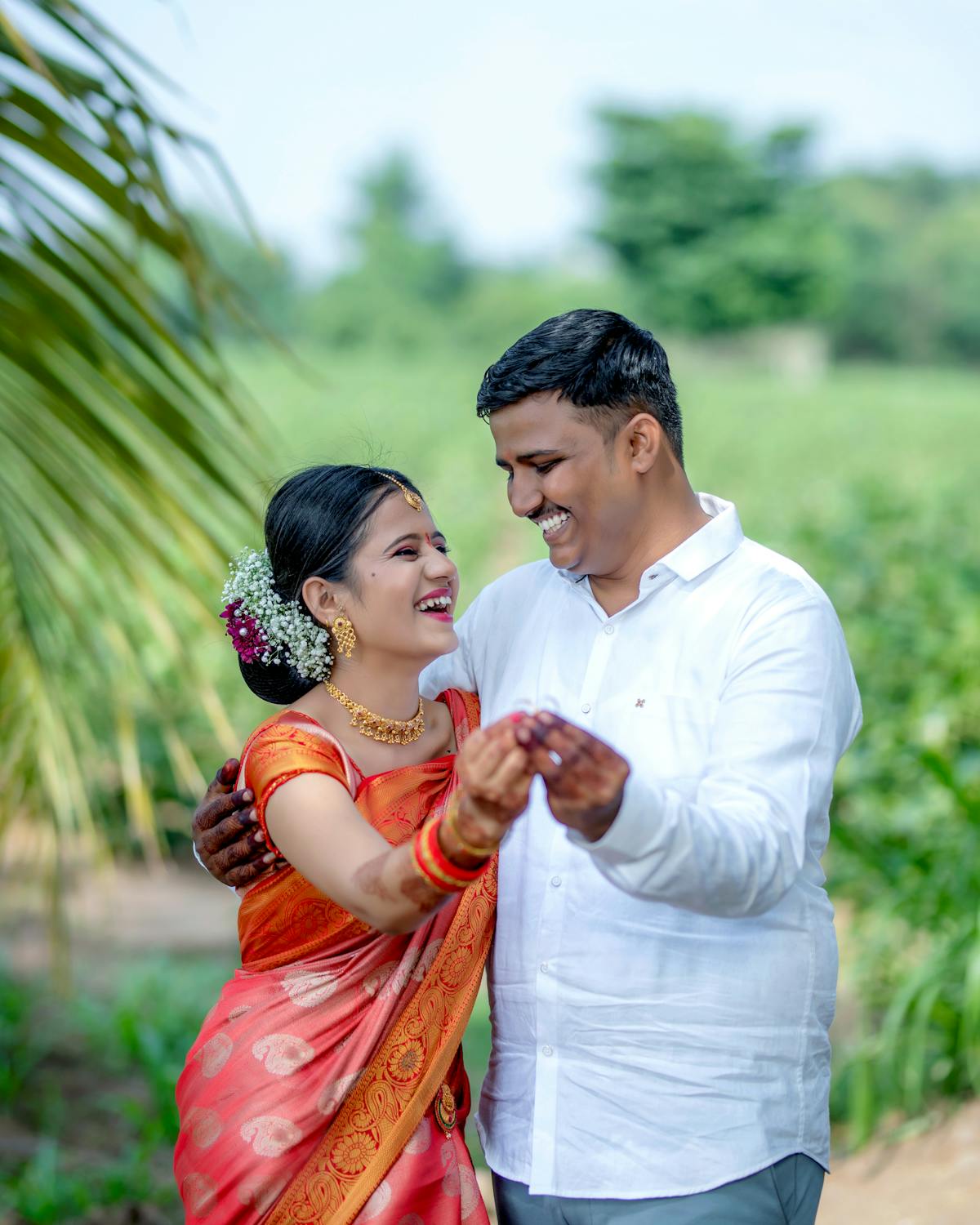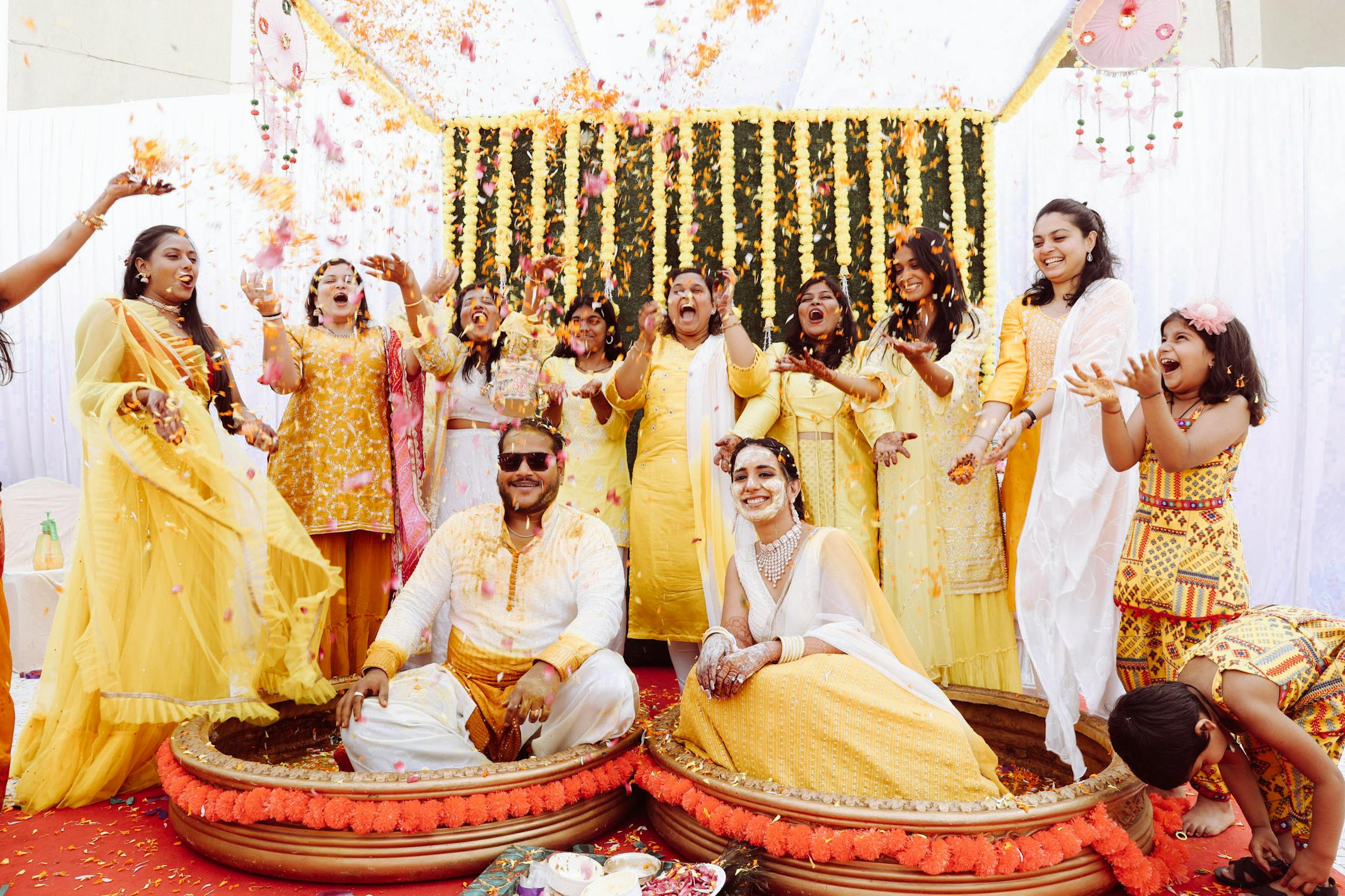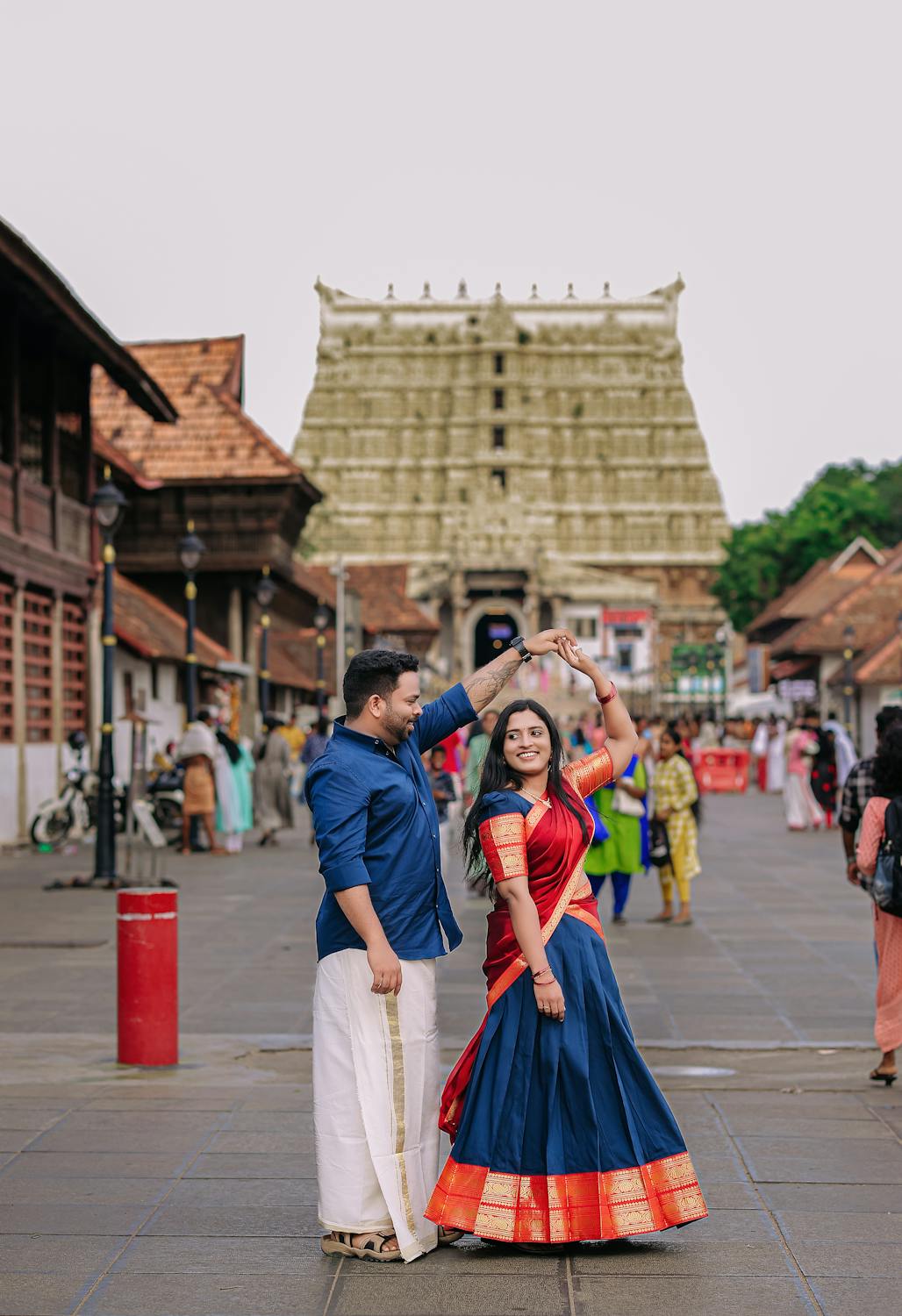Choose another country or store view to see content specific to your location and shop online.
28 Hindu Wedding Traditions - A Comprehensive Guide
28 Hindu Wedding Traditions - A Comprehensive Guide |Jun 18, 2024
- Share

Wedding days are more than celebrations of love; they are moments of hope and commitment, signifying the beauty of cultural values. From the initial days of enjoyment to the last-minute preparations, there are countless tales to describe the beauty of Hindu weddings. Steeped in customs and traditions, weddings are moments filled with lots of emotions. While the couples chant prayers for a happy life ahead, the elders shower them with blessings. As such, there is much to say about the beauty and auspiciousness of the Hindu wedding ceremony. Read on to get a deep understanding of the different Hindu wedding ceremonies and explore the significance of each with this comprehensive guide. You may also like to read: 1. 35 Different Saree Draping Styles: From Ancient Roots to Contemporary Trends 2. 29 Traditional Indian Bridal Wear from Different States - Comprehensive Guide 3. 29 South Indian Wedding Traditions: Understanding the Bride and Groom's Attire for Each Day The pre-wedding traditions in the Hindu wedding ceremony start with the Lagna Patrika or engagement ceremony. It is the time when the couple formally announces their marriage date with a written vow. Lagna Patrika is a sacred ceremony in which the priest writes down the details of the marriage and the names of the family members. Representing the divinity and importance of the event, holy symbols like ‘om’, ‘swastika’, 'kalash', etc. are found on the Lagna Patrika. Wagdaan is the formal ring exchange ceremony. The groom seeks permission from the bride’s father to marry her and then exchange rings with each other. Wagdaan takes place as a part of the engagement ceremony, which is known as Mangni in North India and Nishitartham in South India. This ceremony is symbolic of the commitment between the couples and represents the importance of receiving blessings from family members at auspicious events like weddings. The Roka ceremony is one of the most important pre-wedding events and is part of the engagement ceremony. In this event, the families from both sides come together, and share gifts and love. The parents of both the bride and groom share their happiness for the couple-to-be and bless them by adorning them with tilak. The Barni Band-hwana ceremony occurs 15 days before the wedding ceremony. This is another important pre-wedding ritual with great significance. During this ceremony, a thread known as ‘mauli’ is tied to the bride and groom’s wrists. The act of tying ‘mauli’ on the couples’ hands is a prayer to God seeking blessings and safety on the wedding day. The Mayra ceremony is an integral ceremony of the Hindu wedding tradition and takes place after Barni Band-hwana. The bride and groom's maternal uncle has a major role in this ceremony. Showering gifts, including sweets, clothing, jewelry, etc. to each other, the ceremony signifies the importance of familial bonds. However, the idea behind this custom is rooted in ancient times, when male members were entitled to inherit familial properties. As a man receives the family properties, he extends support to his sister by contributing to her daughter’s wedding. The event captures the essence of the beauty of the relationship between family members. The Sangeet ceremony is a whole event filled with lots of fun and entertainment for the couples, their families, and friends. The term ‘sangeet’ means ‘to sing together’. The whole spirit of the wedding ceremony is reflected in the enjoyment of the Sangeet ceremony. It is, in fact, a celebration of togetherness that eases the tension of the upcoming wedding ceremony. Music, dance, feasts - everything that evokes a complete celebratory mood can be found in the Sangeet ceremony. The Mehndi party has emerged as one of the most significant events in the Hindu wedding tradition. In this event, the family, friends, and others beloved of the bride apply mehendi to the bride’s hands and feet. With intricate patterns adorning the bride, the Mehndi ceremony is believed to bring happiness, luck, and health to the bride’s future life with her husband. Traditionally, the Mehndi ceremony has been celebrated by the bride and her family, but modern Hindu weddings have the groom getting henna as well. Hindu weddings are more than the union of the bride and groom. It upholds the idea of completion, with both families happily taking part in the union of the couple. Representing familiar values is therefore a crucial part of Hindu weddings and the Tilak ceremony is one of them. In this event, the bride’s family applies an auspicious, red vermillion known as the 'tilak', to the groom’s forehead and rice is sprinkled on his head. The ‘tilak’ is usually prepared with vermilion, sandalwood, turmeric, clay, etc. The Tilak ceremony is performed in different ways in different Indian states, but the idea of the event remains the same. The word ‘Haldi’ means ‘turmeric’ in Hindi. Haldi is a pre-wedding ceremony in Hindu weddings in which a thick paste of turmeric and sandalwood is prepared and applied to the face and body of the bride and groom. This ceremony is known by several names in different regions, such as Mayian, Pithi, Ubtan, etc. The Haldi ceremony usually takes place a day before the actual wedding ceremony. Turmeric has great anti-microbial properties that act as a skin exfoliant and enricher. It is also believed that turmeric has the power to ward off evil eyes and bad spirits. The mood of the event is enhanced by music, dance, and other entertainment activities by the bride and groom’s family and friends. Giving a warm welcome to the groom is a part of the Hindu wedding ceremony. Baraat, also known as ‘Vara Yaatra’, is a ceremony that celebrates the entrance of the groom. The traditional way of celebrating this event involves the groom arriving in a grand procession on an elephant. However, in modern-day Baraat, the groom comes in a car and is welcomed by the bride’s family. The sound of nadaswarams welcomes the groom, indicating a sacred start to the wedding ceremony. The Milni ceremony is usually found at North Indian Hindu weddings. In this ceremony, garlands are exchanged between the male members of the families. This is conducted after the Baraat and represents the unity between both families. The groom’s father and other male members greet and embrace the bride’s father. They then exchange garlands to show love and acceptance for each other. The formal ceremony where the bride’s family welcomes the groom is called Pokwanu. The bride’s mother takes the groom to the wedding venue after applying a ‘tilak’ to his forehead. Another interesting ritual associated with Pokwanu is the groom smashing a clay pot with his foot, symbolising that he can face and overcome all the struggles the couple may encounter in their future lives. Seeking blessings from Lord Ganesh, the remover of obstacles, is a common practice in the Hindu wedding tradition. The priest who performs the rituals invokes Lord Ganesh, asking for his blessings and praying to remove any possible obstacles. The term ‘Kanya’ means ‘girl’ and ‘aagman’ means ‘to arrive’. As the name suggests, Kanya Aagman is the ceremony that marks the arrival of the bride. The bride's maternal uncle and aunt escort her to the wedding mandap, signifying the family's acceptance of the marriage. As the bride walks towards the mandap, she is gracefully sheltered under an adornment made of flowers called ‘phoolon ki chaadar’. The Mandap is the place where the bride and groom are seated for the wedding ceremony. The four pillars of the wedding mandap represent the four different stages of life - Brahmacharya, Grihastha, Vanaprastha and Sanyasa. Even though the rituals conducted in the mandap vary in different cultures, they are usually performed by the priest, who chants Vedic hymns and prays for the couple. As fire has great significance in the Hindu tradition, the bride and groom walk around the fire seven times. The Varmala is the ceremony where the bride and groom exchange garlands with each other. This ceremony is also known by other names like jai mala or milni mala. The wedding garland is a beautiful arrangement of different flowers like jasmine, roses, marigolds, etc. The importance of this ceremony is that as the couples exchange garlands, they accept each other as a part of their families. Kanyadaan is an important ritual in the Hindu wedding ceremony. The literal translation of the word ‘Kanyadaan’ goes as ‘giving away the bride’. The bride’s hand is placed over the groom’s by her family members, who pour sacred water over their joined hands. In the Hasta Milap, the couples’ right hands are tied together with a cloth. This tradition represents the bond between the husband and wife, signifying that it should be strong and unbreakable in their married life. The Grandthibandan is the ceremony of ‘tying the knot’, which represents the oneness of the bride and groom and their sacred relationship. In this ritual, the bride’s pallu and the groom’s scarf are tied together while everyone around them chants mantras and prays for the couple. The word ‘sapta’ means ‘seven’ and ‘padi’ means ‘steps’. It is also known as saath phera and is the ritual where the bride and groom take seven steps together around the fire. As the couple takes each round around the fire, they make different vows. When they complete seven rounds, they take seven vows, each signifying different prayers for prosperity in their future lives, including health, family, food, etc. The mangal sutra and sindoor are two important symbols in Hindu weddings, signifying marital status. The mangalsutra is a beaded necklace tied around the bride’s neck by the groom. In Hindu tradition, the mangal sutra has great importance and every married woman wears it. It is believed that Lakshmi, the goddess of wealth, beauty and prosperity, dwells in the mangal sutra. The sindoor is a red powder (vermillion) that the groom applies to the bride’s forehead on the wedding day. Both the mangal sutra and the sindoor are considered auspicious symbols that signify the purity of the husband-wife relationship. Hindu weddings are not limited to the sacredness of traditions and rituals alone. It is also an occasion where the whole family can celebrate and enjoy themselves together. As a result, there are several moments in the events that make the celebration even more vibrant. The Joota Chupai is one such event where the bride’s sisters hide the groom’s shoes as he removes them before entering the mandap. The groom is playfully asked by the sisters to pay gifts or money to get the shoes back. Evoking laughter and happiness, the Joota Chupai makes the whole celebration memorable. Every new beginning comes with a poignant close to another chapter. The Vidaai is one such emotional moment for the bride and her family, where the bride leaves her home to start a new life with her partner. The beauty of this moment is enhanced even further when the parents tearfully bid farewell to their daughter while deeply praying and wishing her a happy life. The bride takes rice, flowers, and coins in her hands and throws them over her head to her parents to show them her gratitude and love. The word ‘aashirwad’ means ‘blessings’. The Aashirwad ceremony involves the moments when the newlywed couple seeks blessings from their parents to commence their happy lives together. The family members wholeheartedly bless them, while the surrounding guests shower flower petals upon the couple. The Aashirwad is one of the most beautiful traditions of the Hindu wedding, as the joy of the couple and the prayers of the parents blend to create moments that make the day even more auspicious. Cheering up the celebration, the Dwar Rokai is the event where the groom’s sister creates a fun moment in the house. Just like the Joota Chupai event, the groom’s sister playfully blocks the entry of the couple to the home and asks for money or gifts from her brother to let them in. This is one of the most significant rituals in the wedding tradition. During the Griha Pravesh, the groom’s family officially welcomes the bride to their family. The groom’s mother applies tilak to the couple and the elders bless them for a happy life. The rituals of the Griha Pravesh continue as the groom’s family places a pot filled with rice at the entrance near the door and asks the bride to push it with her right foot. As a kickstart to her new life, the bride then takes her next step in a dish full of vermillion powder. The bride walks inside the house, leaving trails of the red powder behind, seeking blessings from Goddess Lakshmi. The ‘Mooh Dikhai’ translates to ‘showing the face’, which is an important post-wedding Hindu tradition. The groom’s mother and other women in the family unveil the bride’s face, offer her gifts and introduce her to the other members of the family. The enchanting and enthralling moments of the Hindu wedding come to a close with the Pag Phera ceremony. In this event, the bride is taken back to her home, usually by her brother, where she stays for the next 2-3 days. By returning to her home, the bride is believed to bring good fortune and happiness to her parents. The groom then takes her back to his house after taking blessings from the bride’s parents. As it is the groom’s first official visit to the bride’s home after marriage, her parents give them several gifts. From pre-wedding to post-wedding events, a series of traditions and rituals make your event even more memorable and sacred. Its rich traditions, filled with grace and grandeur, set Hindu weddings apart from other weddings. Understanding the importance of each ritual and following the traditions will truly make your wedding an exceptional experience you will cherish forever. Explore and experience the widest range of wedding outfits from MSU and make your day unique. All you need to make your wedding more vibrant is the right attire that embraces the spirit of your big day. Make those once-in-a-lifetime moments even more special with the beauty of the exquisite collections from Mysore Saree Udyog. 28 Hindu Wedding Ceremonies That You Need to Know
1. Lagna Patrika

2. Wagdaan

3. Roka

4. Barni Band-hwana

5. Mayra or Mayara Ceremony

6. Sangeet Ceremony

7. Mehndi Party

8. Tilak Ceremony

9. Haldi Ceremony

10. Baraat

11. Milni

12. Pokwanu

13. Ganesh Puja

14. Kanya Aagman
15. Mandap Ceremony

16. Varmala

17. Kanyadaan and Hasta Milap
18. Grandthibandan
19. Saptapadi

20. Mangalsutra and Sindoor

21. Joota Chupai

22. Vidaai

23. Aashirwad

24. Dwar Rokai

25. Griha Pravesh

26. Mooh Dikhai

27. Pag Phera

Celebrate the Purity of Wedding Traditions with Mysore Saree Udyog

